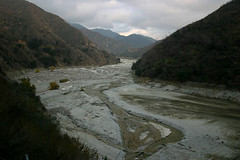Monday, December 26, 2005
Sediment-in-reservoir
It was my birthday today so, I visited the mountains with a friend. What better way to cheer on another year.
The last couple of days the mornings were cool with some fog and then the sun, in early afternoon, would peak out and warm things up. Two days ago it was 87 Fº in Pasadena - nice. I have been planning to go visit the upper watershed and hoped it would stay warm, but alas, the winter clouds won. Still all in all it was lovely.
Water was still pouring in the East tributary of the San Gabriel River. Most of the small waterfalls off the sides of the mountains have been spent. All summer Public Works have been hauling the sediment from the bottom of the reservoir to another location in the mountains to make room for water in the reservoir behind the dam for next year's winter's rains - and to supply water for drought impacted Los Angeles County.
Dams are funny things. We build them to save water and yet they have a limited 'life' span or usefulness. Rivers are a bodies of water which flow from high places to a lower places - they have a much larger body of water beneath the surface in the soils flowing generally in the same direction, albeit slower.The trees and rocks and animals are swept up in the water, too. The flotsam and jetsam that flow on the surface bring minerals to the iron starved oceans and the sediments enrich the effluvial fans surrounding the rivers. The process distributes the plants, animals and water to the surrounding lands, eroding the mountains away. Before people, the washed out trees, brush, and sediments provided protection from predation, material for breeding, and food in the form of islands for the various ocean going organisms.
We build dams. Then rains and snow-melt, which soak through the soils in the mountains, fill the rivers with water. The force of the water washes sediment down the mountain. The sediment fills up the reservoirs behind the dams, which lowers the depth of the man-made lakes. Depending on the amount of rain, and the decomposition of the mountains' soil and rocks, the man-made lakes can, with some bad luck, be filled and useless in ten to twenty years.
I need to visit the new mountain Public Works created from this summer's dredging of sediment....
Subscribe to:
Post Comments (Atom)

No comments:
Post a Comment